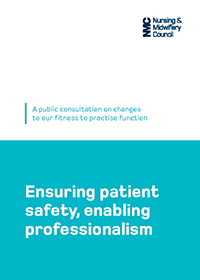Ensuring patient safety, enabling professionalism
A public consultation on changes to our fitness to practise function
We consulted on changes to our fitness to practise function, which we believe will help us to protect the public in a more effective, proportionate and consistent way.
The consultation set out our proposed strategy and asked for your views.
You can read the full consultation documentation.
Consultation reports
You can now read a report on the consultation which was produced by a third party which independently analysed the responses. There were 892 responses to the consultation, with a large majority expressing support for our proposals. The responses were analysed independently by a third party.
In addition to running this consultation we also commissioned a third party to complete a significant programme of targeted qualitative research with 206 people, including patients and service users, employers, and registrants. The research findings also indicated broad support for our planned strategic changes.
Following the 25 July 2018 Council meeting we published our response to the above reports and our new strategy.
What we’re proposing
Our strategy builds on improvements we’ve already made to the way we investigate concerns about nurses and midwives. It puts public protection at the heart of the whole process. We also want our changes to enable professionalism by encouraging an open, learning culture and supporting nurses and midwives to address concerns about their practice.
The changes are based on ten key principles, which address factors such as the purpose of hearings, the need to give nurses the chance to remediate, how employers can deal with complaints and the importance of considering the context of a case. You can find all ten principles on pages 9–10 in the consultation.
What difference will our new principles make?
In this consultation, we’ve used an example scenario to show how these principles could help improve patient safety:
Anne made a medication error while working as nurse in a care home, which resulted in the death of a man receiving end of life care.
On the day it happened, she was distracted by a care assistant and a call from another care home resident. This meant she forgot to check her patient’s blood sugar levels before giving him his insulin. The man hadn’t been given breakfast that day and passed away as a result.
The care home manager dismissed Anne immediately after the incident. She later attended a course on diabetes care and found a new post.
We investigated what had happened. We found that there was a case to answer as she hadn’t remediated in the areas of medicines administration and working in a challenging environment.
We held a hearing, where Anne admitted the allegation. We decided that she still wasn’t fit to practise, because there was still a risk to patient safety.
To protect the public, we made a conditions of practice order. The order stated that the nurse should only administer medicines under direct supervision.
What could have been done differently?
 Our new strategy emphasises helping employers to deal with complaints locally wherever possible. In our scenario, Anne was dismissed by her employers immediately. However, the employer could have tried to manage this situation at the care home first and given the nurse the further training she needed. Their investigation would also have highlighted any problems in the care home environment, making the home safer for all residents.
Our new strategy emphasises helping employers to deal with complaints locally wherever possible. In our scenario, Anne was dismissed by her employers immediately. However, the employer could have tried to manage this situation at the care home first and given the nurse the further training she needed. Their investigation would also have highlighted any problems in the care home environment, making the home safer for all residents.
Our strategy also says we should consider the context of a case when deciding what action to take. In this example, Anne was the only registered adult nurse working in a 20 bed care home. If we decide that the nurse was working in a system that might have caused any professional to make the same mistake, then we wouldn’t take the case any further. We may instead refer the home to a systems regulator.
Another key point is that we want to give nurses and midwives the opportunity to remediate when they can. We could have contacted Anne to set out what we think the regulatory concern is and advise on how she could remediate this concern and remove any public protection concerns. For example, she could have done training in medications administration.
Learn more and get involved
You can read more information about the changes (Cymraeg) and share your views with us.






